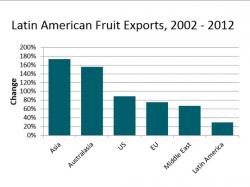Latin America, More, More, More Exports
June 5, 2013 | 3 min to read

Fruit exports from Latin America have been booming over the last 10 years. This looks set to grow in the future, with overall volumes from a cross section of countries, including Chile, Brazil, Mexico, Peru and Argentina, having increased (across all horticultural categories), and to all markets, from some 45.7 million tonnes to under 82 million tonnes. This represents almost a doubling the total volume of exports in just a 10 year period.
And while all international markets have seen their imports from these Latin American suppliers increase, the growth in some international markets has been especially impressive. Exports to Asian markets have increased by some 173% over this 10 year period, to Australasian markets exports have increased by some 156% and to Africa, the increase in Latin American trade has been a staggering 2,500% but from of course a low base. Exports to the EU from Latin America have increased by around 75% and to the US by 90% and to the Middle East just under 70%. Regional trade to other neighbouring Latin American countries has increased by some 30%.
The general wisdom these days is that the real growth in exports will come from fast emerging markets, especially in Asia. While it is true that exports from Latin America have increased to Asian markets from 2 million tonnes to over 5 million per annum, the reality is that regions such as the EU and North America still account for 32% and 45% of overall exports. Interestingly, these proportions have remained relatively unchanged over the last 10 years. Latin American exports to neighbouring markets account for 12% of exports, the Middle East is still less than 2%, Asia around 7% and Africa and Australasia less than 1 % of overall exports. The EU, US and Asia are clearly the big opportunity areas for the forthcoming period, but interest in non traditional markets, not least in Africa, cannot be ruled out either for future opportunities.
So for all the talk of the future for international fruit suppliers (and not just in Latin America) – being in the emerging markets, the real picture is somewhat different. EU and US markets are still of critical overall importance to Latin America and will continue to be so in the future. While it is only right that new opportunities are sought out in the emerging economies (and Latin America has been as successful here as anyone), there is danger in that by switching commercial, technical and promotional attention to these markets too quickly and too exclusively, that hard won markets in more mature economies are neglected.
This would be a mistake and there is a clear need to adopt a well defined portfolio approach to international markets based on the maxim of “how much we want these respective markets” and just as importantly, “how much they really want us”, and adopting a strategy of “maintain, build, invest or lastly, treat as opportunistic only”.
This can only be achieved by examining and researching key opportunities and developing a high level of economic, political, social and market understanding. With new market opportunities opening up around the world all the time, only investment in this type of analysis can see growers and exporters pick the right markets at the right time and this maybe is the greatest challenge of all for the Latin American fruit supply chain.
John Giles is a Divisional Director with Promar International, a leading agri food value chain consulting firm and a subsidiary of Genus plc. He is also the current Chair of the Food, Drink & Agricultural Group of the Chartered institute of Marketing and can be contacted at the following email: john.giles@genusplc.com
Source: Promar International
